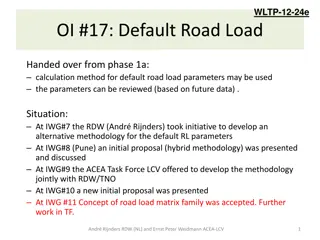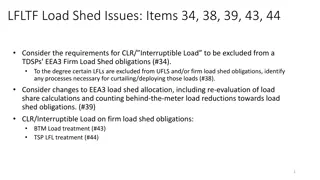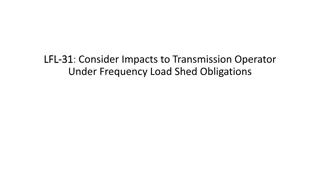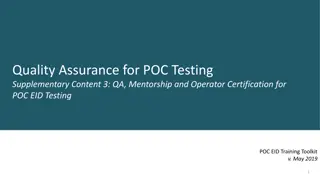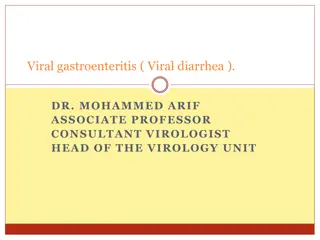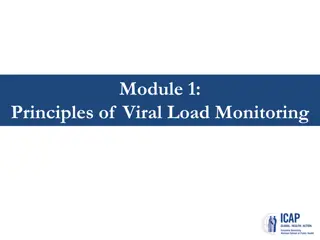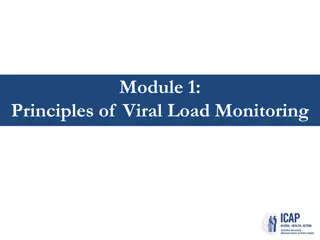Facilitating Informed Product and Site Selection for EID and Viral Load Testing
In the diagnostics sector, the lack of comprehensive information has hindered decision-makers in selecting appropriate testing products. This tool aims to assist Ministries of Health in making transparent and rational decisions based on unique priorities such as patient volumes, clinical needs, access challenges, and cost efficiency. By involving key stakeholders, utilizing key principles, and following a structured process, countries can harmonize and optimize product and site selection for efficient testing coverage.
Download Presentation

Please find below an Image/Link to download the presentation.
The content on the website is provided AS IS for your information and personal use only. It may not be sold, licensed, or shared on other websites without obtaining consent from the author.If you encounter any issues during the download, it is possible that the publisher has removed the file from their server.
You are allowed to download the files provided on this website for personal or commercial use, subject to the condition that they are used lawfully. All files are the property of their respective owners.
The content on the website is provided AS IS for your information and personal use only. It may not be sold, licensed, or shared on other websites without obtaining consent from the author.
E N D
Presentation Transcript
Background: Why is a product selection process necessary? Comprehensive product information Historically, in the diagnostics sector, decision-makers have lacked sufficient information to make informed product selection decisions Suppliers provide Ministries of Health (MOHs) with extensive marketing materials, but they lack comprehensive and unbiased information to pick the products that are most appropriate for their countries Public procurement principles Public funding requires that public procurement principles be observed in the procurement of commodities. MOHs have an obligation to demonstrate that a rational and transparent process has been followed to select products for procurement. There is a role to play for neutral 3rd parties to facilitate the development of a rational and transparent product selection process. 2
Key Principles of Product and Site Selection 1. It should be MOH-led and involve all key stakeholders to drive consensus 2. It should be rational, transparent, and well-documented 3. It should be driven by the country s unique diagnostic testing priorities, including such factors as: a. Patient volumes b. Clinical need (i.e., potential need for emergency EID testing in hospitals) c. Access challenges (low-volume sites with long turnaround times and/or sites that are located far from centralized testing labs) d. Cost efficiency 4. It should be an iterative process 3
Product and site selection tool are just part of a broader process Review product information Convene TWG Select products for evaluation Product selection Conduct evaluations Note: Countries are increasingly working to harmonize and share evaluation results to minimize duplication. Review evaluation results Convene TWG Select products for Pilot/scale-up Product selection Site selection tool Pilot/Scale-up
The product and site selection tool and accompanying guidance can be used to facilitate stakeholder discussions Understand current testing landscape o Understand the current gaps in testing coverage in the country: What segments have the poorest access to testing? At what level of the health system do most patients seek care? Which segments of the health system would be best served by POC? Determine key criteria o Determine the most important ~5 10 criteria when selecting POC products o Discuss how these criteria should be weighted against each other in each segment o Determine balance between patient numbers, access, and price to be used in site selection Review product pipeline and assign scores to products o Review all available information for each product o Assign scores for each of the products for the criteria determined in step 2 Select POC products and sites o Review scores for each product in the various segments o Hold discussions across all stakeholders to consider scores and other relevant factors o Select products for evaluation and/or scale-up and match to appropriate sites o Repeat process periodically to include new products and new information 5
EID and VL Site and Product Selection Tool Overview (1 of 5) Goal: Help countries determine optimal deployment of POC and conventional equipment at a site level to maximize patient impact while maintaining cost efficiency 1 Define country and site-level information o Enter details regarding country guidelines, existing equipment, lab operations, sample transportation, costs, and site-level patient data, including but not limited to: ART patients PMTCT patients OR historical EID test numbers Existing access to testing (EID or VL) Distance from lab or turnaround time in days Presence of pediatric or nutrition ward 2 Assign site selection criteria o Weight most important criteria for site selection, including minimizing cost, improving on-site access to testing, or maximizing patient coverage o Choose maximum number of devices to be deployed per site 6
EID and VL Site and Product Selection Tool Overview (2 of 5) 3 Assess existing coverage through conventional systems and role of POC o Outputs of site-level data used to define access to on-site testing o User can test various scenarios shifting balance from conventional to POC at national level to determine potential patient and cost impact o This will help inform the overall balance between POC and conventional testing in country 7
EID and VL Site and Product Selection Tool Overview (3 of 5) 4 Determine key criteria for new product selection o Identify all the factors that should be considered when selecting new product o Identify percentage weights to be given to each criteria Performance Criteria Tests Offered (EID or VL) Quantitative/Semi-Quantitative Device/Device-Free Throughput Power Source Connectivity Device Cost Reagent Cost Ease of Use After-Sale Support >0 and <=5 >5 and <=10 >10 and <=20 5% >20 10% 5% 5% 5% 15% 10% 20% 10% 10% 15% 15% 25% 10% 15% 5% 10% 5% 15% 20% 10% 20% 10% 15% 20% 20% 10% 20% 10% 15% 20% 5 Review product pipeline and assign scores to products 6 Select new products to deploy 8
EID and VL Site and Product Selection Tool Overview (4 of 5) 7 Score and select sites and assign products o Sort sites to rank from highest to lowest based on EID, VL, or both o Select which sites will be chosen for new product deployment o Designate product for all chosen sites 9
EID and VL Site and Product Selection Tool Overview (5 of 5) 8 Review outputs and adjust as necessary o Review model outputs, including: o Distribution of on-site access to testing by facility size o List of sites and devices selected o Required budget o Average cost per test o Public health impact o Adjust model outputs based on findings 10
Introducing New POC Devices in Zimbabwe: Focus on Early Infant Diagnosis May 2016
Agenda Zimbabwe POC Implementation Guidelines Case Study: POC Product Selection Case Study: POC Site Selection 12
Implementation guidelines: Driven by countrys overall plan The POC Guidelines Development Task Force was formed by Ministry of Health and Child Care Department of Laboratory Services (MOHCC-DLS) to draft POC Testing Guidelines; Actively participated by key partners: MLSCZ, ZINQAP, CHAI, UNICEF, EGPAF, JSI ,MSF, ZNA, AFZ, NBTS In 2015, the National POC Testing Guidelines was approved by the MOHCC Permanent Secretary The POC Testing Guidelines : Define the strategy for POC, including guidelines and criteria for selecting products and sites for deployment; Include a roadmap for product-agnostic systems for training, quality assurance, supply chain and distribution, service and maintenance, data management, and M&E; Per the POC Testing Guidelines Facilitation of the product selection process has included both quantitative scoring and qualitative discussion among MOHCC-led TWGs and specific programs such as PMTCT and HIV/TB.
Agenda Zimbabwe POC Implementation Guidelines Case Study: POC Product Selection Case Study: POC Site Selection 14
Key Principles of Product Selection per POC Testing Guidelines 1. It must be led by the MOHCC-DLS 2. The process should involve all key stakeholders to drive consensus 3. Rational and transparent criteria will be used to identify the most suitable products 4. The process should be well documented demonstrating the rationale for the selection of suitable products 5. The tools should be flexible so that Zimbabwe can customize the process according to its needs 6. The process must be iterative as the laboratory network and available technologies evolve 15
Product Selection Case Study: Zimbabwe POC EID Attendance: National Microbiology Reference laboratory (NMRL/MOHCC), EGPAF, MSF, UNICEF, CHAI 1 Understand current testing landscape for EID o CHAI presented on the current access to on-site testing in Zimbabwe o The group focused on: Largest segments where pediatric patients seek HIV care and treatment; Segments with poor access to on-site testing and where there is availability to off- site testing; 2 Determine key criteria for POC EID selection o The group identified all the factors that should be considered when selecting POC EID Devices o The top 11 criteria were determined o The group discussed the percentage weights to be given to each criteria: 16
Product Selection Case Study: Zimbabwe POC EID 3 Review product pipeline and assign scores to products for POC EID o CHAI presented the available information on each of the products o The group discussed features and advantages of each of the products o The group determined scores for each of the products against each of the 11 criteria *Performance Criteria scored from a low of 1 to a high of 5 18
Product Selection Case Study: Zimbabwe POC EID 4 Select POC EID products o The tool provides scores for each product in each segment o The group discussed the resulting scores: o Which products scored best in each segment? o Were the results expected? If not, what was missed? o What additional data is required to improve the accuracy of the scores? o Are the differences between various top scoring products significant? o How many products are needed in the country? o The group, led by MOHCC, documented its selections with formal meeting minutes o The group made plans to repeat this process in the future 19
Agenda Zimbabwe POC Implementation Guidelines Case Study: POC Product Selection Case Study: POC Site Selection 20
Key Principles of Site Selection per POC Testing Guidelines 1. It must be led by the MOHCC-DLS 2. The process should involve all key stakeholders to drive consensus 3. Should be driven by the country s unique diagnostic testing priorities, including such factors as: a. Patient volumes b. Access challenges (low-volume sites with long turnaround times and/or sites that are located far from centralized testing labs) c. Alternative entry points for testing (i.e., pediatric wards & nutrition rehabilitation unit for EID) 4. The process should be well documented demonstrating the rationale for the selection of suitable sites 21
Site Selection: Zimbabwe mapped all sites by key criteria and selected sites most appropriate for POC diagnostics deployment based priorities Key criteria Patient volumes at each site: shall consider actual/expected volume based on number patients requiring the tests Distance from a regional lab: accessibility of the testing site to the nearest conventional lab for back up, monitoring and quality assurance ART coverage rate :high number of ART patients at the facility requiring VL testing for care monitoring HIV prevalence: intend to consider sites or entry and testing points with high HIV burden for high patient impact Road quality: will consider hard to reach sites due to difficult terrain/ impassable road to provide onsite access to testing Country Priorities Prioritizing more remote facility within each province Patient volumes: moderate/low volume sites with long turnaround time Access to labs: sites that are located far from centralized testing labs and no reliable sample transport mechanism
There is a sweet spot for sites where laboratory based and POC testing make economic sense based on throughput, cost and complexity Lowest volume sites Highest volume sites Suited to laboratory based Suited to POC Actual share of the market will depend on: 1. Country preference Leverage current laboratory based platforms? 2. Price points for device/reagents Cost of POC test vs laboratory based + sample transport 3. Throughput of POC/near-POC # of machines required to meet patient need vs. burden on health workers 4. Guidelines on DBS Without DBS, laboratory based may not be able to reach peripheral sites
Site-level data can be used to identify gaps in testing coverage and target opportunities to use POC to maximize linkage to treatment Market Segmentation by facility level and EID sample volumes Test Provincial Hospitals District Hospitals Health Centers TOTAL Need/day >10 Tests per Day 0% 5% 0% 5% 5-10 Tests per Day 0% 5% 0% 5% 2-5 Tests per Day 1% 8% 5% 14% 1-2 Tests per Day 0.5% 13% 8% 21% 0-1 Tests per Day 0% 15% 40% 55% 1.5% 46% 53% 100% TOTAL Most sites test only 0-1 patients per day. Some combination of district hospitals and health centers with greatest unmet need and poor access may be the best use cases for EID POC. 24 Note: This is sample data from an analysis of 2015 Zimbabwe EID Market Segmentation Analysis
Next Steps 1. Present the outcome of the product and site selection to the TWGs 2. Evaluate/Review the impact of site selection on testing coverage 3. Review the final list of sites and devices selected for POC pilot deployment and eventual scale up 4. Develop the deployment plan and execute product deployment to selected sites 25






